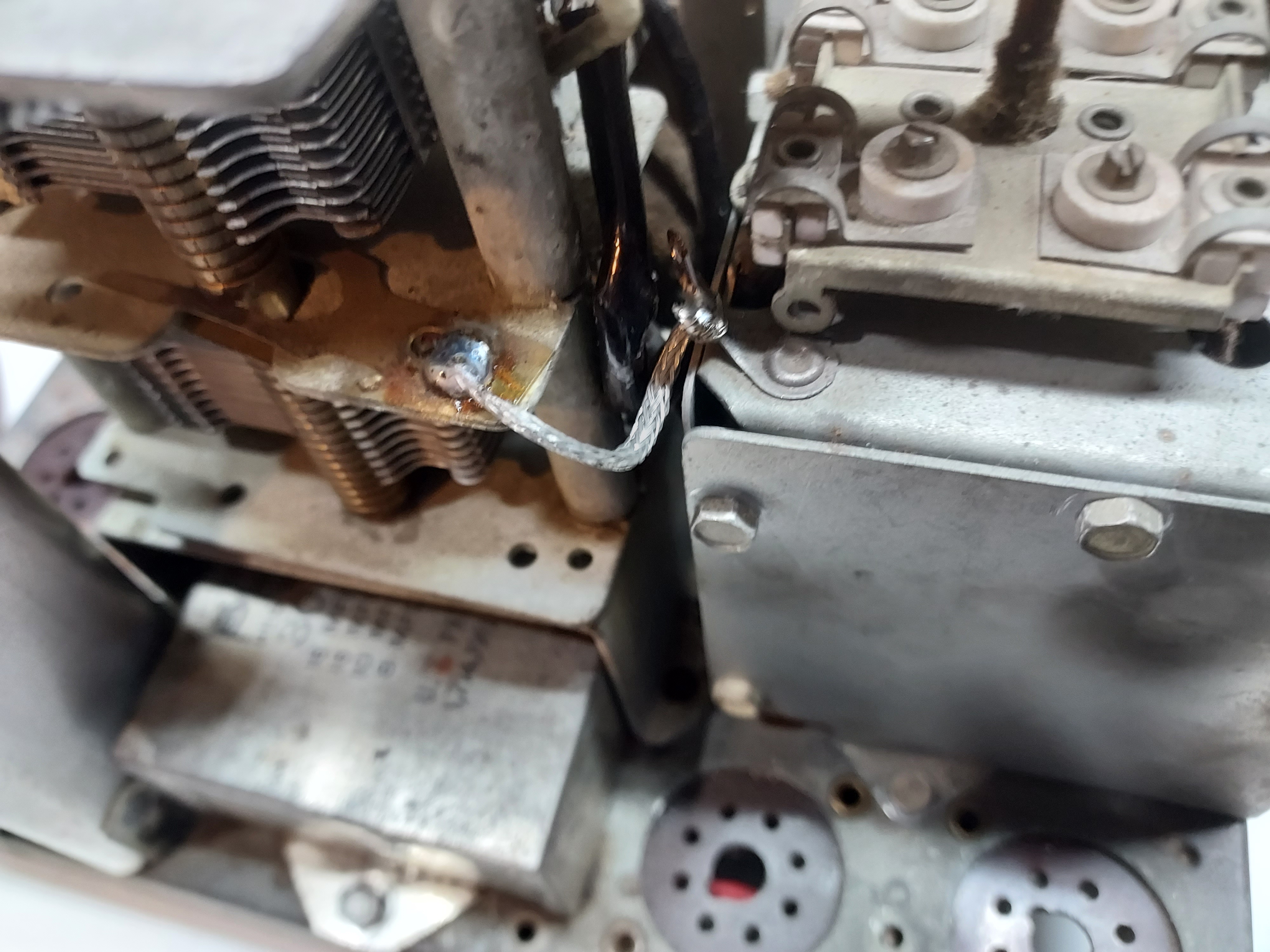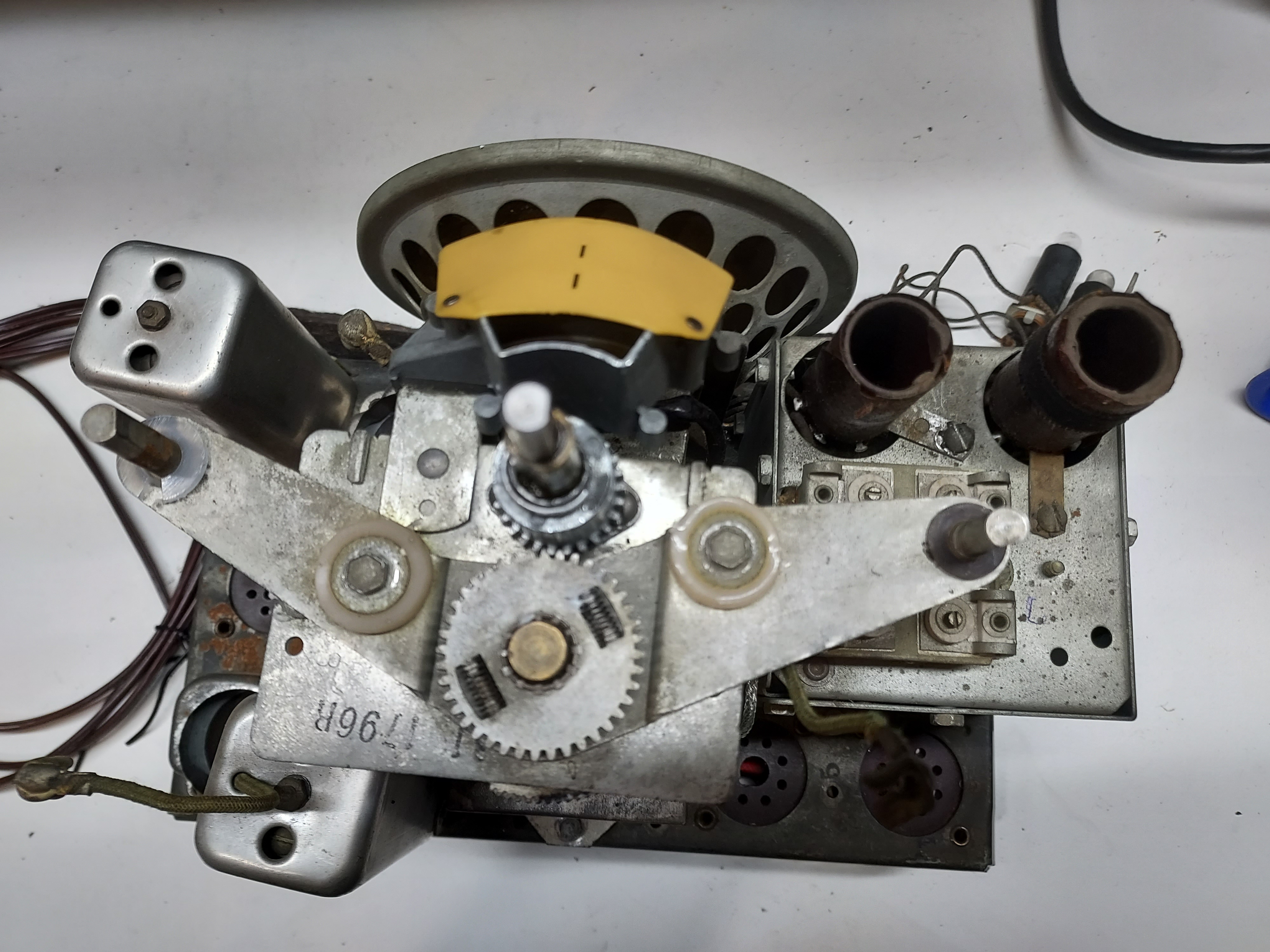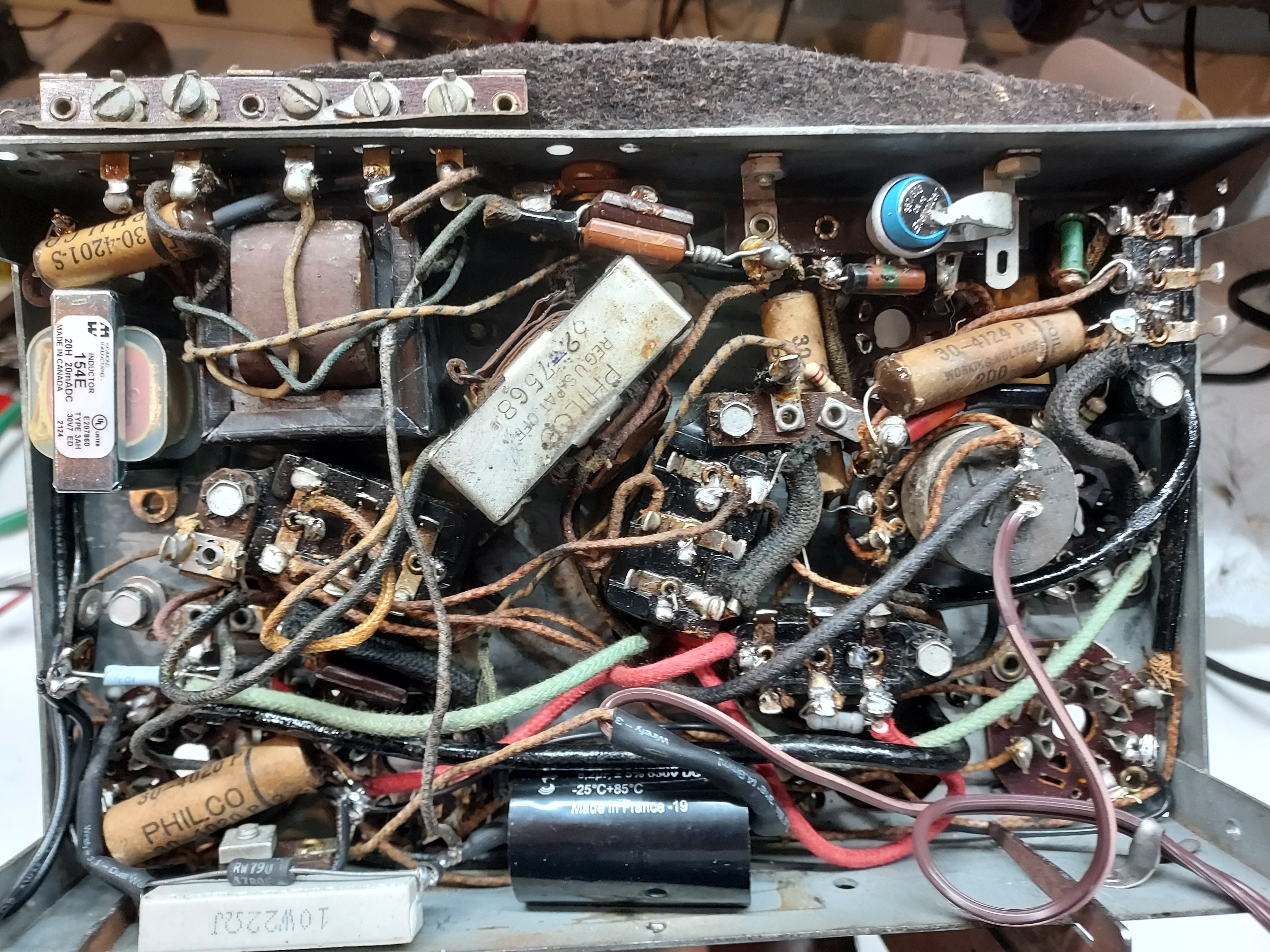Posts: 16,533
Threads: 573
Joined: Oct 2011
City: Jackson
State, Province, Country: NJ
Now I think it is ready.
I had some braided wire, so I used the braid instead of the broken one, connecting the tuning cap to the chassis.

All assembled:

I also forgot I still ahd the cap from the volume pot wiper not installed. At the same time I remembered I did not check the AVC resistor, which turned out to be over 6M vs 2M required; it also got replaced.
All done now.

Possibly will try power-up tonight.
People who do not drink, do not smoke, do not eat red meat will one day feel really stupid lying there and dying from nothing.
Posts: 16,533
Threads: 573
Joined: Oct 2011
City: Jackson
State, Province, Country: NJ
Sure'nuff.
Before I plugged it in, I decided to see the continuity.
After not seeing it, I remembered I put a cap in series, so I switched to the capacitance meter. Still no luck.
So I eventually did what I needed to do before: check the power switch.
See the first line.
Will have to open it and try to fix.That is, I could power up without it, but will have to do it anyway, so why not now.
The fun copntinues...
People who do not drink, do not smoke, do not eat red meat will one day feel really stupid lying there and dying from nothing.
Posts: 4,908
Threads: 54
Joined: Sep 2008
City: Sandwick, BC, CA
Mike;
I looked at the schematic for that set, what an odd duck. Why would they use two filter chokes, and a field coil speaker, it almost defeats the economic advantage in building an AC/DC set over an AC one? I have a Kadette radio from the same era, 1936, and the only choke is in the field coil speaker. James Skinner must have been taking time off when this design was approved.
By the way, I think that the two shaft bushings may have been a phenolic material, possibly to isolate the control shafts from the chassis, otherwise they likely would have pressed a brass bushing in each hole, and called it done.
Regards
Arran
Posts: 16,533
Threads: 573
Joined: Oct 2011
City: Jackson
State, Province, Country: NJ
Arran
Yes, odd.
This said, one of the choke (the 2200 ohm one) quit, and it was working with overload (it is a 10mA choke that potentially saw 12-13mA current).
They might've wanted to really filter the output stage power to possibly diminish hum (I am yet to find out what it is) and so they used a separate LC with a lower DCR/higher current capacity choke, but they might've also wanted to decouple the output from the RF/OSC stage, so they used two.
Talking about odd: using the battery for the 1st Audio bias, how'bout it?
And yes, the bushing is, I think, a phenolic-impregnated fiber. So my nylon one should work just fine.
People who do not drink, do not smoke, do not eat red meat will one day feel really stupid lying there and dying from nothing.
Posts: 4,908
Threads: 54
Joined: Sep 2008
City: Sandwick, BC, CA
Those bias cells are an odd idea, but they are (unfortunately) quite common in Canadian Rogers, and Canadian Marconi sets, most of those use two of the wretched things. I could be wrong but I think the 37-604C may have been the only Philco model to actually use a Mallory bias cell, I don't think that even their battery operated radios did, they had "C" batteries sometimes, but not under the chassis. I have a Canadian Stewart Warner 6 volt set that uses a pair of them, in series, under the chassis, which is a little more understandable since the set uses battery tubes, so directly heated cathodes/filaments but I could never wrap my head around why an AC operated radio should incorporate bias cells when there were plenty of competing makes and models that never used them. In the case of Rogers built sets, my 10-60, a 1935-36 model does not have bias cells, they used cathode resistors, and bypass caps instead, those silly bias cells really seem like the answer to a question that nobody was bothering to ask. Even the question of patent royalty avoidance doesn't make sense since all companies in Canada belonged to a patent pool, which is why you occasionally see a Philco model with a factory installed RCA jack.
Regards
Arran
Posts: 16,533
Threads: 573
Joined: Oct 2011
City: Jackson
State, Province, Country: NJ
So, I took Deoxit D, lifted the cardboard dust cover from the pot, and, having located some openings, sprayed a little of it in.
I tried to keep the pot upright, so the cleaner does not go to the pot section.
Within a couple of minutes I had good contact in closed position.
Then I dripped some F5 to the shaft, in hope it penetrates to the rheostat and worked it a bit.
Will let it dry first.
People who do not drink, do not smoke, do not eat red meat will one day feel really stupid lying there and dying from nothing.
Posts: 1,268
Threads: 11
Joined: Jul 2020
City: Greenlawn
State, Province, Country: NY
I used WD40 (gulp) to clean several toggle power switches for RCA Radiola 16, 17, 18 and 60 sets. However, this is before I bought the DeOxIt D and R5 Fader Lube when I got into restoring Audio mixers and PA systems.
I have an RCA 6BT that use 4 of those Mallory bias cells in the IF (-2V) and Convertor (-4V) AVC circuits (As if the bias developed by the AVC circuit was not enough). My 5BT uses 2 cells (2V on both the IF and Converter grids through the AVC circuit). Seems to work fine with the cells bypassed, but I am in a local area with plenty of stations and I run the radio on a power supply so I am not toasting B Batteries. The Bias for the Audio is an entirely different story. The bias voltage is there from 5 AA alkalines.
"Do Justly, love Mercy and walk humbly with your God"- Micah 6:8
"Let us begin to do good"- St. Francis
Best Regards,
MrFixr55
Posts: 16,533
Threads: 573
Joined: Oct 2011
City: Jackson
State, Province, Country: NJ
R5 is not Fader Lube. R5 was power booster for original contact cleaner.
F5 is the Fader lube.
People who do not drink, do not smoke, do not eat red meat will one day feel really stupid lying there and dying from nothing.
Posts: 1,268
Threads: 11
Joined: Jul 2020
City: Greenlawn
State, Province, Country: NY
(Insert Homer Simpson "DOPF" Here.)
When all fails, look at the can. Took the Ron Ramirez advice, red Caig DeOxIt BAD for pots, green DeOxit GOOD for pots. The contact cleaner (Dunno the Caig product code, I am too lazy to go to the shop now) is red. The F5 can is green and states that it is for pots and faders. Both products are excellent.
"Do Justly, love Mercy and walk humbly with your God"- Micah 6:8
"Let us begin to do good"- St. Francis
Best Regards,
MrFixr55
Posts: 16,533
Threads: 573
Joined: Oct 2011
City: Jackson
State, Province, Country: NJ
Yep. F5 is green, D5 is Red.
Red is Bad.
Green is Clean.
People who do not drink, do not smoke, do not eat red meat will one day feel really stupid lying there and dying from nothing.
Posts: 16,533
Threads: 573
Joined: Oct 2011
City: Jackson
State, Province, Country: NJ
So, I put the wires back to the power switch, plugged it in, slowly increasing the Variac output...nothing. No DC, not even AC.
Eventually, after 5 minutes, I remembered that some plugs, if fully inserted into my Variac (bought new, but, well...Chinese) do not make contact, so I pulled it back a little bit.
Briefly saw the AC, then checked the DC voltages on the caps, then I pretty much rotated the tuning cap and pulled in the local station.
Here's the video.
https://www.youtube.com/shorts/PcZLxpJqnr4
It's a start.
People who do not drink, do not smoke, do not eat red meat will one day feel really stupid lying there and dying from nothing.
Posts: 4,908
Threads: 54
Joined: Sep 2008
City: Sandwick, BC, CA
Usually, if I am overhauling a radio, I am pretty close to taking the volume control out anyhow with having to replace caps or resistors around it, so if it's stiff, or dirty, I pull it out, dismantle it, and clean it out manually with rubbing alcohol. I leaned to do this when working on old farm battery radios, such sets usually sit untouched for decades, even a lot of the sets I repaired have been sitting unused for a decade or more, so the controls are pretty gummed up, even in the bushing the shaft goes through.
Regards
Arran
Posts: 16,533
Threads: 573
Joined: Oct 2011
City: Jackson
State, Province, Country: NJ
Arran
I had a negative experience with IPA. It simply started taking off the carbon off of the rheostat. I quickly stopped.
If I had a pot open, I will either use a dry cotton swab or simply blow it from the can, and then add some F5 and work the wiper to distribute it.
This pot has that long twisted extension shaft, which I am not sure that it could be taken out.
And, when I wanted to take the whole thing out, I realized that there were so many wires in each lug, plus there is a tap, and I was simply afraid to damage it, as, I am sure, this one is rare, and that special shaft would make it a bear to replace.
Most times, if the switch needs attention, and the pot does not have to be taken out, I leave it; if it does, then I extract it. In either case, I put my Trollmaster (that hand-pump for lubing pots), filled with F5, to the shaft and push some in. The switch, if open, typically does not need D5: a cotton swab with IPA takes the dirt off.
People who do not drink, do not smoke, do not eat red meat will one day feel really stupid lying there and dying from nothing.
Posts: 16,533
Threads: 573
Joined: Oct 2011
City: Jackson
State, Province, Country: NJ
Well, now it is the pilot lights.
The two bulb sockets, of course, have disintegrated inside.
It would be not too bad to fix the wire/spring assembly, but both sockets were riveted, or, rather, used an eyelet to hold to the bracket that held them to the dial assembly, and those came apart also.
They were flared really thin, so when I was taking the bulbs out, the flared part easily separated.
Now I have a dilemma: either to look for eyelets (will go to Michael's tomorrow) or try to fit all new sockets.
Oh, and the reception during the filming yesterday: I forgot to switch off the light and the rear power strip: today I did it and it became really good with luittle noise.
People who do not drink, do not smoke, do not eat red meat will one day feel really stupid lying there and dying from nothing.
Posts: 4,908
Threads: 54
Joined: Sep 2008
City: Sandwick, BC, CA
Mike;
That can be a concern, especially with Japanese pots, but the ones I was dealing with were used in 1930s and 40s Canadian made battery sets, and the resistive elements in those seem to hold up to the common solvents, in those days they used to spray pots and switches with carbon tetrachloride. Most of them also had no opening behind the terminals, so you couldn't easily spray anything into theme. My biggest headache is when a radio fell victim to the control replacement racket that was common in the 1950s and 60s, where they would replace a perfectly good control because it was dirty. The "magic one control fits all", replacements often didn't very well, or were installed crudely, though this was more the case with AC or AC/DC sets then battery sets.
Regards
Arran
Users browsing this thread: 1 Guest(s)
|
|
Recent Posts
|
|
Philco newbie with P-1891-WA console questions
|
| Well, I've been stumped at trying to get the first of 11 electrolytic capacitors. I got a schematic and have a list of t...Jeffcon — 07:54 PM |
|
Model 80 Antenna Issue?
|
| Thanks Gary and Rod.
I also found an article in the Philco Repair Bench under Service Hints and Tips, about installi...Hamilton — 12:32 PM |
|
Model 80 Antenna Issue?
|
| Hello Hamilton, here is a little information found in our Philco Radio Library at the bottom of the Home page. Hope it ...GarySP — 11:28 AM |
|
Model 80 Antenna Issue?
|
| I did as you suggested and touching the middle of the volume control did nothing so the coil has to be rewound. Any idea...Hamilton — 10:19 AM |
|
1949 Motorola 5A9M
|
| This would be the second portable in the "other radios" forum where I have a similar one in my collection. I h...Arran — 12:41 AM |
|
Looking for any info: 1977 Ford-Philco Console Hi-Fi Turntable and Radio
|
| Hi PittsburgTost.
The record changer looks like a Garrard or BSR (Likely Garrard). The spindles just pull out and pu...MrFixr55 — 11:57 PM |
|
Looking for any info: 1977 Ford-Philco Console Hi-Fi Turntable and Radio
|
| Hello PittsburghToast ,
Welcome aboard and it looks like gary may have something for you !
now if I dig through my se...radiorich — 11:35 PM |
|
Model 80 Antenna Issue?
|
| You are kind of on the right path. You can touch the grid cap of the Detector/Oscillator 36 tube. I'm expecting a respon...RodB — 08:48 PM |
|
Looking for any info: 1977 Ford-Philco Console Hi-Fi Turntable and Radio
|
| Welcome to the Phorum, PittsburghToast! I found an old thread that my interest you regarding the quality and worth of P...GarySP — 08:48 PM |
|
Looking for any info: 1977 Ford-Philco Console Hi-Fi Turntable and Radio
|
| Welcome to the Phorum!
:wave:
We do not have anything on that unit in our digital library. There is a Sam's Photof...klondike98 — 08:47 PM |
|
Who's Online
|
There are currently 1193 online users. [Complete List]
» 4 Member(s) | 1189 Guest(s)
|
|
|

|
 
|






![[-] [-]](https://philcoradio.com/phorum/images/bootbb/collapse.png)


